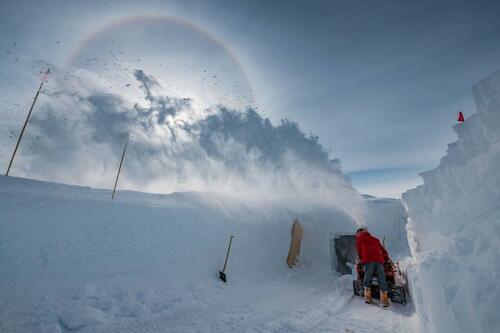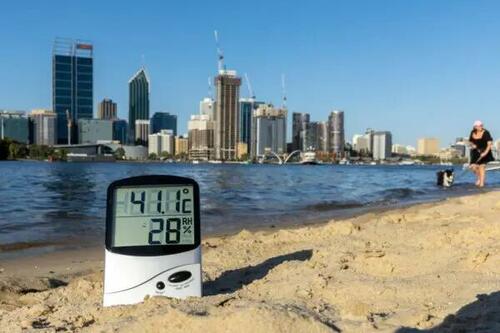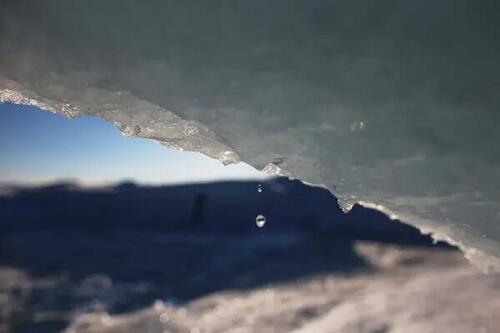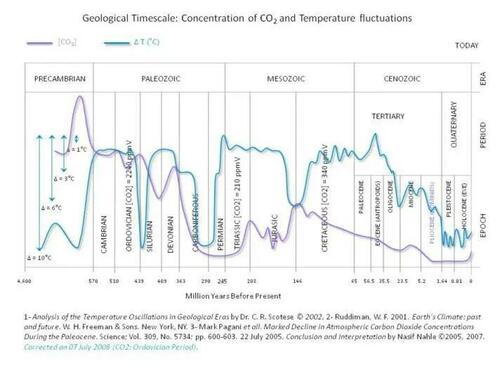Amazing article which helped me see the light and realize that I was a "New Denialist"! What an amazing concept which applies to scientists (mostly I suppose) who believe (quite rightly) that the Earth is warming (very slightly and moderately as 0.7C in 100 years would indicate) starting from a very low base in 1880 and that mankind has very little to do with it. (As many scientists in many fields, glaciology, geology, oceanography and others also believe.)
The problem with Global Warming is not scientific. There is a debate. Some people argue for one side, others against. This is normal and the truth should emerge, slowly but eventually from this debate.
Politics doesn't work like that. The decisions being taken imply trillions of dollars and must therefore be based on certainties. And therefore the debate must be stifled less a doubt remains and policies cannot be implemented, including, in the emergency "packages", solutions which have nothing to do with climate and everything to do with control...
Authored by Graham Young via The Epoch Times (emphasis ours),
Could Michael Mann, the inventor of the so-called Hockey Stick graph, be a covert “New Denialist”? Or is there a split happening in the pro-climate change camp?

That’s two readings of Mr. Mann’s latest book “Our Fragile Moment.”
Either being true would be a good thing, and both are even better.
The “new denialists” is a new term coined to describe people who believe that while climate change is real, it is an open question of how much is manmade, and what the policy response should be.
Mr. Mann is not someone whom you would normally associate with such a position.
He has been famous in climate circles since 1998 when, as a newly-minted doctor in geology and geophysics, he was the principal author of Mann, Bradley, and Hughes 1998 (MBH98), also known as the Hockey Stick graph, a paleoclimate reconstruction of 1,000 years of earth’s temperature which showed unprecedented warming in the late 20th century.
It undermined the consensus view which was that temperature fluctuates quite significantly over centuries, and it was probably cooler now than it had been during the Roman climatic optimum and the Medieval warm period.
You may have seen its star role in Al Gore’s agitprop “An Inconvenient Truth” (“agitprop” because the film was ruled by a British court to be unsuitable for showing to school students without accompanying corrections because it contained “nine scientific errors”).
Mr. Gore had the graph on a large backdrop and emphasised the steepness of the blade, and thus the urgent need to stop CO2 emissions, by rising up beside it in a scissor lift while holding a large pointer in his hand.
Very dramatic.

Some Issues With How the Hockey Stick Came About
That graph and successor hockey sticks are the standard bearers (if you’ll forgive me for mixing metaphors) of climate change catastrophism, and they’ve been used to hit (metaphor again) “climate deniers” over the head.
I’ve never had any regard for the hockey stick.
Not only did it purport to erase the consensus on the basis of one reconstruction, but its statistical techniques were shown to produce hockey sticks out of any random data. So it seemed unlikely to be correct.
But on top of that, Mr. Mann did something that is completely impermissible in statistical analysis.
When the proxy data that he was using came into the modern era they clashed with thermometer records. They showed cooling but the thermometers showed warming.

Mr. Mann “fixed” this by abandoning the proxies and splicing actual temperature records in, without revealing the reason.
This is why I call him “Piltdown Mann.”
The one “n” Piltdown Man is a scandal where an amateur paleoanthropologist claimed to have found the “missing link” between man and ape but it was a forgery where a modern human cranium had been combined with an orangutang jaw and teeth.
Mr. Mann’s technique is similarly defective and deceptive.
If the proxies don’t measure real temperature now, how could they be supposed to be measuring real temperature in the past? The whole proxy exercise had obviously failed and should have been abandoned.
If you want a further, very succinct reference on the Hockey Stick, I can only refer you to the judge in the case of Mann v. Simberg and Steyn, currently running in court 132 in the District of Columbia Superior Court. Mr. Mann is suing the two defendants for some very caustic comments about his hockey stick.
Presiding Justice Irving said:
“As to Mr. Steyn, his statements about the bogus, fraudulent nature of the Hockey Stick graph in his mind were substantially and entirely true.”
Unfortunately, Mr. Mann won, and the matter is likely to go on appeal, but the case deserves an essay all of its own, so I will leave that there for the moment.
Not the End of the World?
So I approached the opportunity to review Mr. Mann’s latest book with caution. A man who will mislead his scientific colleagues is likely to be even less reliable with the general public.
I was not disappointed, and at the same time, I was.
On the one hand, some propositions are surely false, while on the other there were insights that are most probably true. And then the final twist, where Mr. Mann showed himself to be relaxed about the near-term prospects for the world, unlike, say, prophets of doom like Greta Thunberg.

This is where he joins the ranks of what is being termed the “new denialists,” which seems to be a term to cover anyone who takes a “Don’t Panic” approach to changes in the climate.
The book is an example of the seductiveness of capitulating to expert opinion. Mr. Mann has a theory of everything, and that is that CO2 is the thermostat that controls Earth’s temperature. Except he occasionally allows for the sun to have a role at times through Milankovitch cycles.
Unlike most climate scientists, he understands geology and has a long-term view of the world, which means there are a lot of weeds for the amateur to get lost in.
My advice is to read the book, and then go and search out some contrary views.
The future might be all speculation, but once you get further back than yesterday’s dinner, the past can be just as speculative.
Maybe CO2 is a genuine thermostat, but then how do you explain this graph where the earth can be quite cold with high concentrations of CO2 and warm with low concentrations?
Mr. Mann deals with some of this by the concept of Earth System Sensitivity, which is the idea that there is a certain amount of inertia in the earth system and it may take quite a time for changes to manifest.
He posits that sensitivity may be higher in interglacials, and lower during glacials, partly a result of the fact that ice sheets, which dominate glacials, reflect a lot of sunlight and therefore act to keep temperature low, despite changes in CO2 pushing temperature in the other direction.
Ice sheets therefore melt very slowly causing temperature to also warm very slowly.

That brake on temperature change doesn’t exist when most of the ice sheets have melted, as they have today, so warming can be more instantaneous.
Perhaps.
I think it needs a lot more research but do please delve into the book—it has a wealth of detail which is hard to convey accurately, or at all, in a short review.
And definitely read the last chapter where I will let Mr. Mann speak for himself:
“But breathless claims of imminent climate-driven ‘human extinction’ and ‘runaway warming’ are both scientifically unsupportable and unhelpful.”
Let’s Do This Properly
I’ve always been a “new denialist,” or if not always, since somewhere in the 90s.
Manmade climate change is a fact, to the extent that emissions of CO2 created by us have some effect on the climate. But to what extent is an open question, as is what to do about it.
What is certain is that the cost to human life of precipitately stopping the use of fossil fuels is immeasurably higher than any benefit.
We rely on them not just for electricity and transport, but for steel, plastics, glass, explosives, and fertilisers, without which it would be impossible to sustain the 10 billion or so humans who will live on this earth by the end of this century.
If we stopped all that tomorrow, how many humans could the earth support? 500 million? Take that figure from 10 billion, and that’s how many billions you would kill.
It would be wise to transition away from fossil fuels, and also wise to understand that any transition will be in the order of centuries, not decades.
After all, the first steam engine was developed in 1712, but it wasn’t until the early 20th century that it became dominant in sailing technology. Internal combustion engines have been around since 1860, but they are still developing.
Why should the decarbonised economy take only a matter of decades?
But to have a rational debate it requires rational premises all around, and this book is a good contribution to it.
And hopefully, it reflects a broader recognition amongst realists on the more climate-catastrophic end of the debate that if everything is a crisis, people will become so worn out that eventually, nothing is a crisis, because what’s the point, we can’t do anything about it?
Crisis overload.
If Mr. Mann can help to cool the debate, then I’m happy to have his support, even if his science might be less than rigorous.
“Our Fragile Moment: how lessons from the Earth’s past can help us survive the climate crisis” is published by Scribe and retails for AU$35.
Views expressed in this article are opinions of the author and do not necessarily reflect the views of The Epoch Times or ZeroHedge.


No comments:
Post a Comment